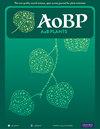A mixture of grass-legume cover crop species may ameliorate water stress in a changing climate
IF 2.4
3区 生物学
Q2 ECOLOGY
引用次数: 0
Abstract
Climate change models predict increasing precipitation variability in the mid-latitude regions of Earth, generating a need to reduce negative impacts of these changes on crop production. Despite considerable research on how cover crops support agriculture in a changing climate, understanding is limited of how climate change influences the growth of cover crops. We investigated the early development of two common cover crop species – crimson clover (Trifolium incarnatum L.) and rye (Secale cereale L.) – and hypothesized that growing them in mixture would ameliorate stress from drought or waterlogging. This hypothesis was tested in a 25-day greenhouse experiment, where the two factors (species number, water stress) were fully crossed in randomized blocks, and plant responses were quantified through survival, growth rate, biomass production, and root morphology. Water stress negatively influenced the early growth of these two species in contrasting ways: crimson clover was susceptible to drought while rye performed poorly under waterlogging. Per-plant biomass in rye was always greater in mixture than in monoculture, while per-plant biomass of crimson clover was greater in mixture under drought. Both species grew longer roots in mixture than in monoculture under drought, and total biomass of mixtures did not differ significantly from the more-productive monoculture (rye) in any water condition. In the face of increasingly variable precipitation, growing crimson clover and rye together has potential to ameliorate water stress, a possibility that should be further investigated in field experiments.在不断变化的气候条件下,草-豆类覆盖作物混种可缓解水资源压力
气候变化模型预测,地球中纬度地区的降水变化会越来越大,因此需要减少这些变化对作物生产的负面影响。尽管对覆盖作物如何在不断变化的气候中支持农业进行了大量研究,但人们对气候变化如何影响覆盖作物生长的了解仍然有限。我们研究了两种常见覆盖作物--深红三叶草(Trifolium incarnatum L.)和黑麦(Secale cereale L.)--的早期生长情况,并假设将它们混合种植可缓解干旱或水涝造成的压力。这一假设在一项为期 25 天的温室实验中得到了验证。在该实验中,两个因素(物种数量、水胁迫)在随机区组中进行了完全交叉,并通过存活率、生长速度、生物量产量和根系形态对植物的反应进行了量化。水胁迫以截然不同的方式对这两个物种的早期生长产生了负面影响:深红三叶草易受干旱影响,而黑麦在水涝条件下表现不佳。黑麦的单株生物量在混合栽培中总是高于单株栽培,而深红三叶草的单株生物量在混合栽培中干旱时更大。在干旱条件下,两种植物在混合物中长出的根都比单一栽培的长,混合物的总生物量在任何水分条件下都与产量更高的单一栽培(黑麦)没有显著差异。面对日益多变的降水,将深红三叶草和黑麦混在一起种植有可能缓解水分胁迫,这种可能性应在田间试验中进一步研究。
本文章由计算机程序翻译,如有差异,请以英文原文为准。
求助全文
约1分钟内获得全文
求助全文
来源期刊

AoB Plants
PLANT SCIENCES-
CiteScore
4.80
自引率
0.00%
发文量
54
审稿时长
20 weeks
期刊介绍:
AoB PLANTS is an open-access, online journal that has been publishing peer-reviewed articles since 2010, with an emphasis on all aspects of environmental and evolutionary plant biology. Published by Oxford University Press, this journal is dedicated to rapid publication of research articles, reviews, commentaries and short communications. The taxonomic scope of the journal spans the full gamut of vascular and non-vascular plants, as well as other taxa that impact these organisms. AoB PLANTS provides a fast-track pathway for publishing high-quality research in an open-access environment, where papers are available online to anyone, anywhere free of charge.
 求助内容:
求助内容: 应助结果提醒方式:
应助结果提醒方式:


